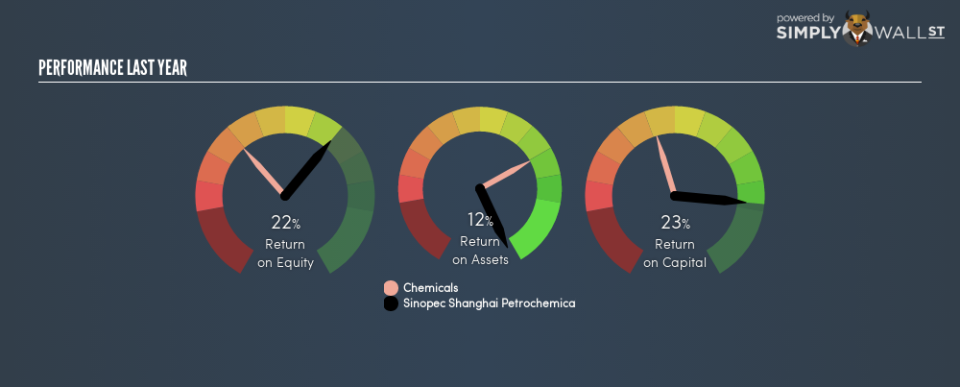Why You Should Like Sinopec Shanghai Petrochemical Company Limited’s (HKG:338) ROCE

Want to participate in a short research study? Help shape the future of investing tools and you could win a $250 gift card!
Today we’ll look at Sinopec Shanghai Petrochemical Company Limited (HKG:338) and reflect on its potential as an investment. Specifically, we’ll consider its Return On Capital Employed (ROCE), since that will give us an insight into how efficiently the business can generate profits from the capital it requires.
First up, we’ll look at what ROCE is and how we calculate it. Then we’ll compare its ROCE to similar companies. Then we’ll determine how its current liabilities are affecting its ROCE.
Return On Capital Employed (ROCE): What is it?
ROCE measures the amount of pre-tax profits a company can generate from the capital employed in its business. All else being equal, a better business will have a higher ROCE. In brief, it is a useful tool, but it is not without drawbacks. Renowned investment researcher Michael Mauboussin has suggested that a high ROCE can indicate that ‘one dollar invested in the company generates value of more than one dollar’.
How Do You Calculate Return On Capital Employed?
Analysts use this formula to calculate return on capital employed:
Return on Capital Employed = Earnings Before Interest and Tax (EBIT) ÷ (Total Assets – Current Liabilities)
Or for Sinopec Shanghai Petrochemical:
0.23 = CN¥6.5b ÷ (CN¥42b – CN¥12b) (Based on the trailing twelve months to September 2018.)
Therefore, Sinopec Shanghai Petrochemical has an ROCE of 23%.
View our latest analysis for Sinopec Shanghai Petrochemical
Does Sinopec Shanghai Petrochemical Have A Good ROCE?
ROCE can be useful when making comparisons, such as between similar companies. In our analysis, Sinopec Shanghai Petrochemical’s ROCE is meaningfully higher than the 11% average in the Chemicals industry. We would consider this a positive, as it suggests it is using capital more effectively than other similar companies. Putting aside its position relative to its industry for now, in absolute terms, Sinopec Shanghai Petrochemical’s ROCE is currently very good.
Our data shows that Sinopec Shanghai Petrochemical currently has an ROCE of 23%, compared to its ROCE of 10.0% 3 years ago. This makes us think the business might be improving.
Remember that this metric is backwards looking – it shows what has happened in the past, and does not accurately predict the future. Companies in cyclical industries can be difficult to understand using ROCE, as returns typically look high during boom times, and low during busts. This is because ROCE only looks at one year, instead of considering returns across a whole cycle. What happens in the future is pretty important for investors, so we have prepared a free report on analyst forecasts for Sinopec Shanghai Petrochemical.
Sinopec Shanghai Petrochemical’s Current Liabilities And Their Impact On Its ROCE
Current liabilities include invoices, such as supplier payments, short-term debt, or a tax bill, that need to be paid within 12 months. Due to the way ROCE is calculated, a high level of current liabilities makes a company look as though it has less capital employed, and thus can (sometimes unfairly) boost the ROCE. To counter this, investors can check if a company has high current liabilities relative to total assets.
Sinopec Shanghai Petrochemical has total liabilities of CN¥12b and total assets of CN¥42b. Therefore its current liabilities are equivalent to approximately 29% of its total assets. The fairly low level of current liabilities won’t have much impact on the already great ROCE.
What We Can Learn From Sinopec Shanghai Petrochemical’s ROCE
Low current liabilities and high ROCE is a good combination, making Sinopec Shanghai Petrochemical look quite interesting. Of course, you might find a fantastic investment by looking at a few good candidates. So take a peek at this free list of companies with modest (or no) debt, trading on a P/E below 20.
If you like to buy stocks alongside management, then you might just love this free list of companies. (Hint: insiders have been buying them).
To help readers see past the short term volatility of the financial market, we aim to bring you a long-term focused research analysis purely driven by fundamental data. Note that our analysis does not factor in the latest price-sensitive company announcements.
The author is an independent contributor and at the time of publication had no position in the stocks mentioned. For errors that warrant correction please contact the editor at editorial-team@simplywallst.com.

